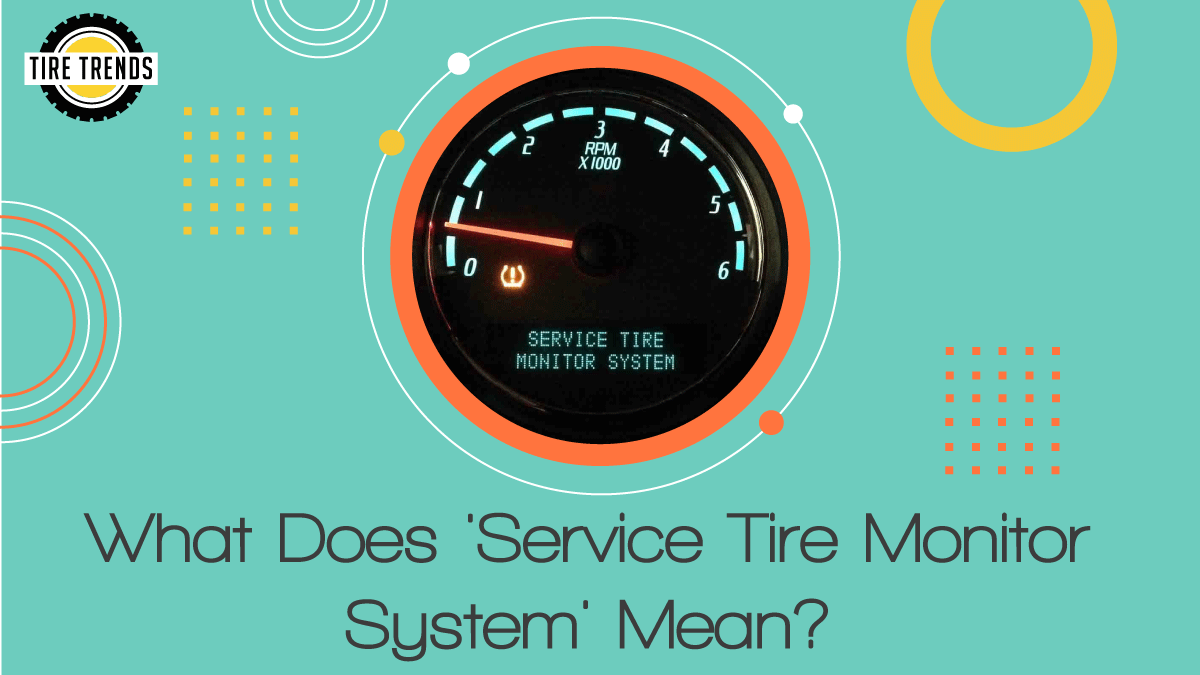Welcome to the world of TPMS, where tires and technology converge to ensure a smooth and safe driving experience. As you hit the road, you may come across the mysterious message “Service Tire Monitor System.” But fear not! In this comprehensive guide, we’ll unravel the secrets behind TPMS, explore its functionality and common causes of the message, and provide troubleshooting tips and maintenance recommendations.
Get ready to delve into the fascinating world of tire monitoring systems and gain the knowledge you need to decipher the TPMS message with confidence. Let’s embark on this enlightening journey together!
Understanding Tire Monitor Systems

A. Definition and Functionality
The Tire Monitor System (TPMS) is a technology designed to monitor tire pressure and provide timely alerts to drivers. It enhances safety, prolongs tire life, and improves fuel efficiency. TPMS consists of sensors, communication protocols, and monitoring methods.
TPMS sensors are installed in each tire and continuously measure the air pressure. They wirelessly transmit this data to the vehicle’s onboard computer, which analyzes the information and alerts the driver if any tire pressure deviates from the recommended range. TPMS ensures that the tires are properly inflated, maximizing performance and safety.
B. Types of TPMS
There are two main types of TPMS:
- Direct TPMS: This type uses individual sensors mounted inside each tire to accurately measure the air pressure. The sensors wirelessly transmit data to the vehicle’s computer, enabling real-time monitoring and providing precise information about each tire’s pressure.
- Indirect TPMS: Indirect TPMS relies on wheel speed sensors present in the vehicle’s anti-lock braking system (ABS). It calculates potential deviations in tire pressure by monitoring the rotational speed of each tire. While indirect TPMS is less expensive, it may not provide measurements as accurate as direct TPMS.
Both types of TPMS serve the common purpose of monitoring tire pressure, although with differences in approach and accuracy.
Common Reasons for “Service Tire Monitor System” Message
Understanding the common causes behind the “Service Tire Monitor System” message is crucial for addressing issues promptly. Let’s explore the main reasons for encountering this warning.
A. Tire Pressure Deviation
Tire pressure deviation is one of the primary triggers for the TPMS warning message. Incorrect tire pressure can negatively affect vehicle performance, fuel efficiency, tire wear, and safety. Consider the following key points:
- Overinflated tires: When tire pressure exceeds the recommended level, overinflation can lead to a harsh and uncomfortable ride due to reduced cushioning. Overinflation also causes increased wear at the tire’s center, reducing its lifespan. Furthermore, overinflated tires have a smaller contact patch with the road, resulting in reduced traction, particularly on wet surfaces.
- Underinflated tires: When tire pressure falls below the recommended level, leading to underinflation, it can result in decreased fuel efficiency due to increased rolling resistance. Underinflated tires are prone to uneven wear, with the tire’s edges wearing more quickly than the center. This compromises handling and overall tire performance. Additionally, underinflation generates excess heat within the tire, increasing the risk of tire failure and potential blowouts, especially during heavy loads or extended drives.

Maintaining the appropriate tire pressure is vital for optimal vehicle performance, safety, and fuel efficiency. Studies indicate that improperly inflated tires contribute to approximately 1.2 billion gallons of wasted fuel annually in the United States alone.
By regularly checking and adjusting the tire pressure to the recommended values provided by the vehicle manufacturer, you can minimize fuel consumption, extend tire life, and ensure safer driving conditions.
B. Sensor Malfunction
TPMS sensors can experience malfunctions, resulting in inaccurate readings and triggering the “Service Tire Monitor System” message. Understanding the common causes of sensor malfunction is important. Consider the following:
- Sensor damage: TPMS sensors can sustain damage due to various factors, such as road hazards, corrosion, or improper handling during tire replacement. Physical damage to the sensors can compromise their ability to measure tire pressure accurately. For example, a sensor that has been hit by a sharp object or exposed to excessive moisture may exhibit faulty readings or become non-responsive. It is crucial to handle TPMS sensors with care during tire replacement and avoid any potential damage.
- Battery failure: TPMS sensors rely on batteries to power their functionality. When the batteries in the sensors run out of power, the sensors become non-responsive and may malfunction. TPMS sensor batteries typically last around 5 to 7 years. However, factors such as battery quality, sensor usage, and environmental conditions can impact the actual lifespan of the batteries. Regular monitoring of battery status is important to ensure the sensors continue to function properly. In case of battery failure, prompt replacement is necessary to restore accurate tire pressure monitoring.
- Radiofrequency interference: TPMS sensors utilize wireless communication to transmit tire pressure data to the vehicle’s computer. However, external factors such as radio signals or electronic devices can interfere with this wireless communication, leading to inaccurate readings or system malfunctions. It’s important to note that certain aftermarket electronic accessories or strong radio frequency signals in the vicinity of the TPMS sensors may cause interference. Minimizing the presence of such interference sources can help maintain the accuracy and reliability of the TPMS system.
Addressing sensor malfunctions promptly is crucial to ensure the accuracy and reliability of the TPMS system. Statistics indicate that approximately 10% of TPMS sensor failures are attributed to battery-related issues. By being mindful of potential sensor damage, monitoring battery life, and minimizing radiofrequency interference, you can help maintain the effectiveness of your TPMS system and ensure accurate tire pressure monitoring.
C. Battery Life
TPMS sensors rely on batteries to function, and understanding when and how to replace these batteries is crucial. Consider the following key points:
- Sensor battery lifespan: On average, TPMS sensor batteries last around 5 to 7 years. However, the actual lifespan may vary depending on factors such as battery quality, sensor usage, and environmental conditions. It’s important to note that extreme temperatures and harsh driving conditions can affect battery life. Monitoring the battery status regularly can help you stay informed about the remaining lifespan of your TPMS sensor batteries.
- Battery monitoring: Some TPMS systems provide battery status information, allowing you to check the remaining battery life directly from the vehicle’s dashboard or TPMS display. This feature enables you to stay proactive in monitoring the health of your TPMS sensor batteries. However, it’s important to note that not all TPMS systems have this functionality. In such cases, professional diagnostic tools may be required to accurately assess the battery health of your TPMS sensors.
- Battery replacement: When the sensor batteries are low or depleted, it is advisable to replace them promptly to ensure accurate tire pressure monitoring. Many TPMS sensors are designed with replaceable batteries, making the maintenance process cost-effective. Refer to your vehicle’s manual or consult a professional technician to determine the appropriate battery replacement procedure for your specific TPMS sensors. It’s important to follow the manufacturer’s guidelines to ensure proper battery installation and synchronization with the vehicle’s computer system.
By proactively monitoring and replacing TPMS sensor batteries, you can help maintain the effectiveness of the TPMS system and prevent unexpected malfunctions. This ensures that the tire pressure readings provided by the sensors remain accurate and reliable, enabling you to address any issues promptly and maintain optimal tire performance and vehicle safety.
Troubleshooting and Maintenance Tips

Understanding how to troubleshoot and maintain TPMS will help address issues effectively. Here are valuable tips to consider:
A. Reacting to the “Service Tire Monitor System” Message
When the TPMS warning message appears on your vehicle’s dashboard, it’s crucial to take immediate action. Ignoring the warning can lead to unsafe driving conditions, compromised fuel efficiency, and increased tire wear. To address the issue promptly, follow these steps:
- Don’t ignore the message: The TPMS warning message is an important indicator that there may be an issue with your tire pressure. Ignoring it can have negative consequences on your safety and vehicle performance. It’s essential to acknowledge the message and take the necessary steps to resolve the issue.
- Check your tires visually: Conduct a thorough visual inspection of your tires to identify any signs of damage, such as punctures, bulges, or uneven wear. Inspect the tread pattern and sidewalls for any visible issues. If you notice any damage, it’s important to address it promptly by either repairing or replacing the affected tire.
- Check tire pressure manually: To accurately assess the tire pressure, use a reliable tire pressure gauge. Attach the gauge to the valve stem of each tire and measure the pressure. Compare the obtained readings with the manufacturer’s recommended pressure values, which can typically be found in the vehicle’s manual or on a placard inside the driver’s door jamb.
- If the tire pressure is lower than the recommended value, it indicates that the tire is underinflated. Underinflated tires can result in reduced fuel efficiency, poor handling, and increased tire wear. In such cases, add air to the tire using an air compressor or visit a nearby service station to achieve the correct pressure.
- On the other hand, if the tire pressure is higher than the recommended value, it indicates overinflation. Overinflated tires can lead to a harsh ride, decreased traction, and uneven tire wear. To correct overinflation, you can release air from the tire using the valve stem cap or by visiting a service station.
It’s important to note that proper tire pressure is crucial for optimal vehicle performance, safety, and tire longevity. Maintaining the recommended tire pressure ensures that the tire’s contact with the road is optimal, enhancing grip, handling, and fuel efficiency.
B. Checking Tire Pressure and Maintenance
Regularly checking and maintaining proper tire pressure is crucial for vehicle safety and optimal performance. Follow these steps:
- Park your vehicle: Ensure the vehicle is parked on a level surface and engage the parking brake for safety.
- Locate the recommended tire pressure: Refer to the manufacturer’s recommended tire pressure values, typically found in the vehicle’s manual or on a placard inside the driver’s door jamb. Inflate the tires to the correct pressure.
- Use a tire pressure gauge: Attach the gauge to the valve stem of each tire and measure the pressure. Compare the obtained readings with the manufacturer’s recommended values. Adjust the tire pressure as needed using an air compressor or by releasing air.
- Regular maintenance: Check your tire pressure at least once a month and before long trips. Visually inspect your tires regularly for any signs of damage or wear, including punctures, bulges, or uneven tread wear patterns.
Maintaining proper tire pressure enhances fuel efficiency, extends tire lifespan, and ensures overall safety.
C. Diagnosing and Fixing Common TPMS Issues

While some TPMS issues require professional assistance, you can troubleshoot and resolve certain problems yourself. Here are some common TPMS issues and possible solutions:
- Inaccurate readings: If you suspect that the TPMS is providing inaccurate readings, consider recalibrating the system or seeking assistance from a qualified technician. Recalibration procedures can often be found in your vehicle’s manual or by using diagnostic tools.
- Sensor replacement: In the case of a faulty sensor, replacement may be necessary. Consult your vehicle’s manual or seek professional guidance for the appropriate sensor replacement procedure. Some sensors may require reprogramming or syncing with the vehicle’s computer after replacement.
- Interference troubleshooting: If external factors like radio signals or electronic devices are causing TPMS interference, try identifying and eliminating the source of interference. This may involve turning off nearby electronic devices or adjusting their placement.
Remember, for more complex issues, or if you’re unsure about how to proceed, it is advisable to consult a professional technician for assistance.
Frequently Asked Questions
1. How often should I check my tire pressure?
It is recommended to check your tire pressure at least once a month and before long trips. Regular monitoring helps maintain optimal tire performance and improves safety.
2. Can I rely solely on the TPMS for tire maintenance?
While TPMS provides valuable information about tire pressure, it is still essential to visually inspect your tires regularly for signs of damage or wear. TPMS is a complement to manual tire maintenance, not a replacement for it.
3. What should I do if the TPMS warning light blinks or stays on?
If the TPMS warning light blinks or remains illuminated, it indicates a potential issue with the system. Check your tire pressure manually and ensure it meets the manufacturer’s recommended values. If the problem persists, consult a professional technician for further diagnosis and assistance.
4. How long do TPMS sensors typically last?
On average, TPMS sensor batteries last around 5 to 7 years. However, the lifespan can vary depending on various factors, such as battery quality, sensor usage, and environmental conditions. Regular monitoring and replacing the batteries when necessary can help maintain the effectiveness of the TPMS system.
5. Is it possible to disable or reset the TPMS system?
Disabling or resetting the TPMS system is not recommended, as it compromises your safety and may violate legal requirements in some regions. The TPMS serves an important purpose in ensuring proper tire pressure and safety. If you encounter persistent issues, it’s best to consult a professional technician for assistance.
Conclusion
Understanding the meaning behind the “Service Tire Monitor System” message and familiarizing yourself with TPMS functionality are crucial for safe and efficient driving. By comprehending the common causes of TPMS warnings, troubleshooting tips, and maintenance practices, you can proactively address tire-related issues and enjoy a smooth driving experience.
Remember to regularly check your tire pressure, visually inspect your tires, and seek professional assistance when needed. Prioritizing TPMS maintenance contributes to improved safety, fuel efficiency, and extended tire lifespan.

